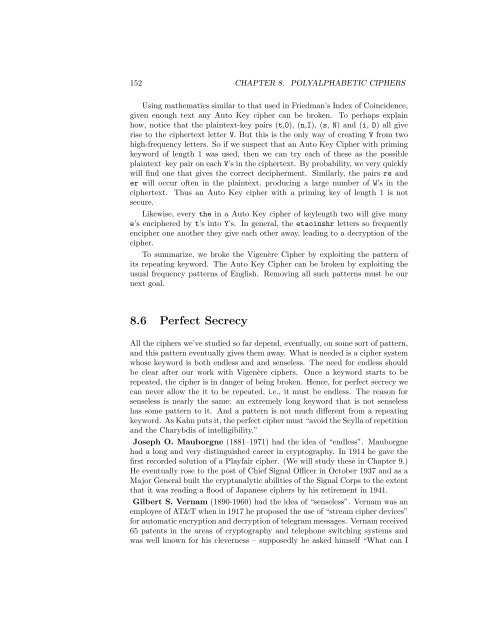Cryptology - Unofficial St. Mary's College of California Web Site
Cryptology - Unofficial St. Mary's College of California Web Site
Cryptology - Unofficial St. Mary's College of California Web Site
Create successful ePaper yourself
Turn your PDF publications into a flip-book with our unique Google optimized e-Paper software.
152 CHAPTER 8. POLYALPHABETIC CIPHERS<br />
Using mathematics similar to that used in Friedman’s Index <strong>of</strong> Coincidence,<br />
given enough text any Auto Key cipher can be broken. To perhaps explain<br />
how, notice that the plaintext-key pairs (t,O), (n,I), (s, N) and (i, D) all give<br />
rise to the ciphertext letter V. But this is the only way <strong>of</strong> creating V from two<br />
high-frequency letters. So if we suspect that an Auto Key Cipher with priming<br />
keyword <strong>of</strong> length 1 was used, then we can try each <strong>of</strong> these as the possible<br />
plaintext–key pair on each V’s in the ciphertext. By probability, we very quickly<br />
will find one that gives the correct decipherment. Similarly, the pairs re and<br />
er will occur <strong>of</strong>ten in the plaintext, producing a large number <strong>of</strong> W’s in the<br />
ciphertext. Thus an Auto Key cipher with a priming key <strong>of</strong> length 1 is not<br />
secure.<br />
Likewise, every the in a Auto Key cipher <strong>of</strong> keylength two will give many<br />
e’s enciphered by t’s into Y’s. In general, the etaoinshr letters so frequently<br />
encipher one another they give each other away, leading to a decryption <strong>of</strong> the<br />
cipher.<br />
To summarize, we broke the Vigenère Cipher by exploiting the pattern <strong>of</strong><br />
its repeating keyword. The Auto Key Cipher can be broken by exploiting the<br />
usual frequency patterns <strong>of</strong> English. Removing all such patterns must be our<br />
next goal.<br />
8.6 Perfect Secrecy<br />
All the ciphers we’ve studied so far depend, eventually, on some sort <strong>of</strong> pattern,<br />
and this pattern eventually gives them away. What is needed is a cipher system<br />
whose keyword is both endless and and senseless. The need for endless should<br />
be clear after our work with Vigenère ciphers. Once a keyword starts to be<br />
repeated, the cipher is in danger <strong>of</strong> being broken. Hence, for perfect secrecy we<br />
can never allow the it to be repeated, i.e., it must be endless. The reason for<br />
senseless is nearly the same: an extremely long keyword that is not senseless<br />
has some pattern to it. And a pattern is not much different from a repeating<br />
keyword. As Kahn puts it, the perfect cipher must “avoid the Scylla <strong>of</strong> repetition<br />
and the Charybdis <strong>of</strong> intelligibility.”<br />
Joseph O. Mauborgne (1881–1971) had the idea <strong>of</strong> “endless”. Mauborgne<br />
had a long and very distinguished career in cryptography. In 1914 he gave the<br />
first recorded solution <strong>of</strong> a Playfair cipher. (We will study these in Chapter 9.)<br />
He eventually rose to the post <strong>of</strong> Chief Signal Officer in October 1937 and as a<br />
Major General built the cryptanalytic abilities <strong>of</strong> the Signal Corps to the extent<br />
that it was reading a flood <strong>of</strong> Japanese ciphers by his retirement in 1941.<br />
Gilbert S. Vernam (1890-1960) had the idea <strong>of</strong> “senseless”. Vernam was an<br />
employee <strong>of</strong> AT&T when in 1917 he proposed the use <strong>of</strong> “stream cipher devices”<br />
for automatic encryption and decryption <strong>of</strong> telegram messages. Vernam received<br />
65 patents in the areas <strong>of</strong> cryptography and telephone switching systems and<br />
was well known for his cleverness – supposedly he asked himself “What can I

















